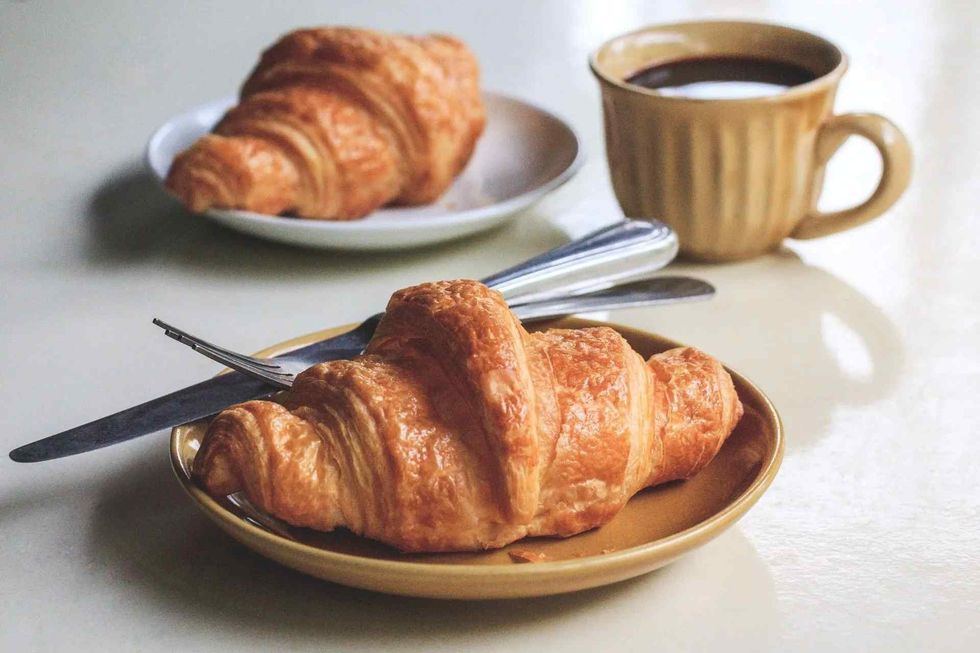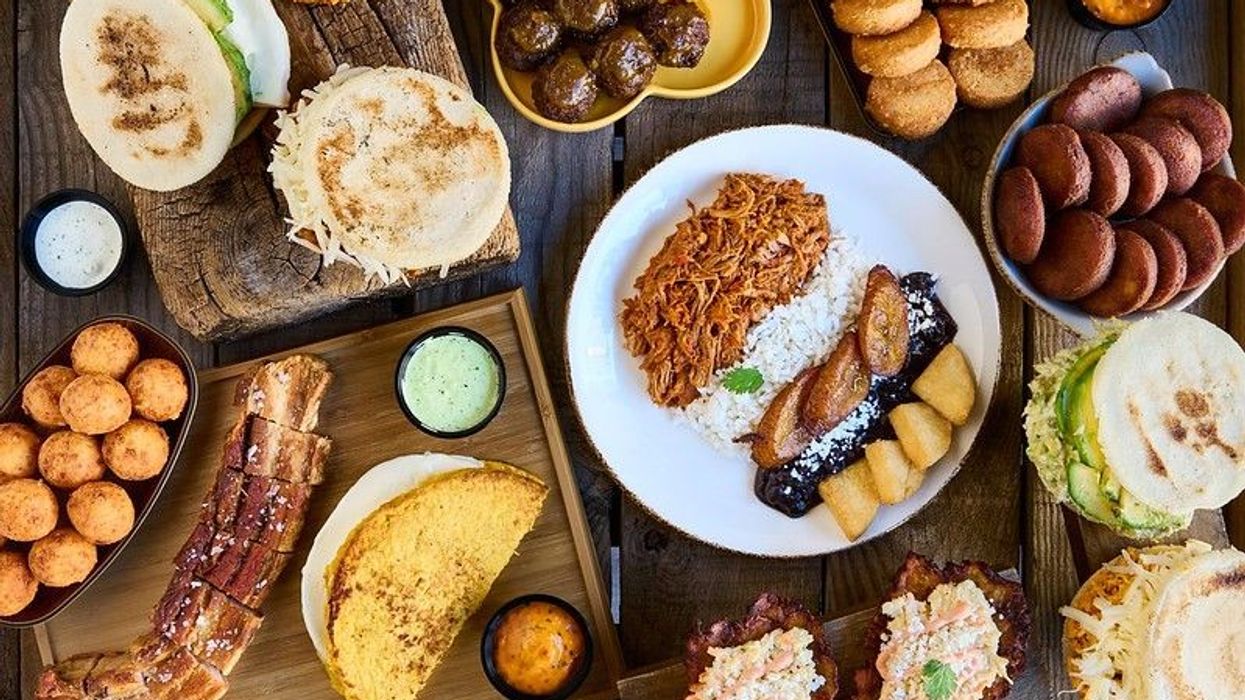65 Croissant Facts That Will Make You Fall In Love With The Pastry
For someone who has never come across a croissant before, it can be described as a crescent shape pastry of golden brown color.
There are various kinds of pastries which are found all over the world. Croissants are regarded as viennoiserie pastries owing to the way they are baked and cooked.
Viennoiseries can be directly translated into 'things of Vienna' and are baked goods which are made from a yeast-leavened dough. The process is similar to that of making bread but there are various additional ingredients that make the final product a pastry rather than just a bread.
Like other viennoiseries, croissants too are made from a yeast-leavened dough but croissant dough is typically folded and rolled several times and some butter is added to the top of the dough.
Once the croissant dough has undergone this process, it then undergoes a process called laminating which results in the flaky texture of the croissant and makes the end product seem a lot like a puff pastry.
Croissants are generally eaten in the morning as a breakfast pastry and are largely associated with France but little do people know that croissants did not originate from France.
Nowadays, you can find different types of croissants all across the world ranging from almond croissants, chocolate croissants to even croissant breakfast sandwiches which are a product of American fast food chains.
The present day croissant is believed to have originated during the '70s when the concept of frozen dough was introduced which isn't the same as a frozen croissant.
Origins Of Croissants
A French croissant, as the name suggests, makes people believe that a croissant is a kind of French pastry that was invented sometime in the past. However, croissants did not originate in France although they became a worldwide sensation owing to the French bakeries which made this crescent shape pastry famous.
Let's delve deeper into the origin and some historical facts about croissants.
- Croissants are believed to have been introduced in France in the 19th century at a Paris based bakery known as Boulangerie Viennoise.
- Croissants are believed to have been derived from a pastry known as kipfrel which is a kind of a bread roll and arguably a croissant's ancestor as well.
- Croissants originally hail from Austria and date back to the 1680s. Croissants that we eat today are pretty similar to kipfrel which started back in the 13th century.
- Kipfrel is available in different shapes and with varying fillings; some have nuts in them while others are plain.
- This kipfrel then travelled to France in 1839 via August Zang who was an Austrian artillery officer by profession.
- August Zang set up a Viennese bakery in Paris known as 'Boulangerie Viennoise' which was known for serving Vienna loaf and kipfrel, croissant's ancestor.
- The items were an instant hit and various French bakeries soon introduced their own version of the kipfrel and named it croissant owing to the crescent moon shape.
- At the same time, there are stories that proclaim that Marie Antoinette introduced croissants to French bakers who then worked on the pastry to perfect it.
- According to historians, the first ever evidence of a croissant was found back in 1853 under the section 'fantasy or luxury breads'.
- Initially, the croissant was introduced as a luxury product to be consumed only by people who belonged to the upper class.
- With the advent of time towards the latter half of the 19th century, croissants were largely consumed by the middle class as the rich preferred a brioche.
- Did you know, in 1920, croissants were declared as the national French product?
- During this time in the '20s, croissants went on to become a breakfast staple at every French bakery.
- The French croissant was best served along with chocolate filling, frangipane, butter or jam depending upon one's choice.
- The taste and flavor of croissants have changed drastically over the years.
- During the initial days, croissants were nothing but freshly baked bread rolls quite different from the crunchy croissants that we eat today.
- The first historical account of a change in the croissant recipe was in the early 1900s when yeasted puff pastry dough replaced the brioche dough.
The Nutritional Value Of Croissants
A croissant is a breakfast staple in various countries all over the world but a modern croissant is often filled with chocolate or has sugar sprinkled on it which makes one wonder if it's a healthy food. You can include the modern croissant in your diet and stay healthy but you need to exercise portion control.
Let's take a look at how croissants fare when it comes to being a nutritious food.
- Usually, a large croissant is around 2.36 oz (67 g) which provides 272 calories owing to the butter and sugar in it.
- A 2.36 oz (67 g) croissant has 1.09 oz (36 g) carbohydrates, only 0.19 oz (5.5 g) of protein and merely 0.05 oz (1.7 g) of fiber in it.
- This data shows that croissants aren't the most healthy food choice; whether it is a frozen croissant or fresh croissants, both are equally lacking in nutrition.
- When it comes to fats and sugars, a plain croissant weighing 2.36 oz (67 g) contains 0.49 oz (14 g) of fat and 0.26 oz (7 g) of sugar. At the same time, a plain croissant has only a few milligrams of sodium in it.
- A change in the size of the plain croissant will directly lead to a change in the number of calories it contains. According to studies conducted, a plain mini croissant contains 114 calories but this number increases to 171 calories when we look at a small croissant.
- Once we add flavors to a plain croissant, the number of calories it contains and its nutritional values change drastically.
- For instance, an average sized chocolate croissant contains as many as 240 calories along with 0.98 oz (28 g) of carbohydrates and merely 0.14 oz (4 g) of protein.
- When we shift from a chocolate croissant or a pain au chocolat to a cheese croissant, the nutritional value changes.
- A small sized cheese croissant has around 174 calories, 0.70 oz (20 g) carbohydrates, 0.14 oz (4 g) of protein, 0.31 oz (9 g) fats and a negligible 0.03 oz (1 g) fiber.
- When we shift to a fruit croissant, the number of calories it contains increases in comparison to a cheese croissant and a pain au chocolat.
- An average sized fruit croissant has 226 calories, 0.38 oz (11 g) fat, 0.14 oz (4 g) protein and 0.95 oz (27 g) carbohydrates.
- Additionally, it has been noted that an extra topping also leads to an increase in the number of calories and an increase in fat content.
- For instance, if you put butter on top of your croissant, you are likely to consume 100 more calories and increase the fat content of the croissant by 0.38 oz (11 g).
- If you pair your plain croissant with cream cheese, your calorie intake will rise by 35 calories and at the same time, a single serving of cream cheese has 0.12 oz (3.5 g) of total fat in it.
- The best way to include croissants into a healthy diet is by eating plain croissants and topping them with fresh fruit instead of jelly or jam as the laminated croissant dough already contains butter.

Different Types Of Croissants
A large variety of croissants are found all across the world. They vary largely depending upon the fillings they have within them. Some croissants have sweet fillings while others might have a butter filling or an almond filling - commonly known as almond croissants. Some have ham stuffed in between.
- In South American countries such as Uruguay and Argentina, a croissant is a common side dish while sipping coffee.
- In countries like Argentina and Uruguay, people refer to croissants by the term 'medialunas' or 'half moons' owing to the croissant shape.
- There are two types of croissants that are eaten in these countries: one of them has a sweet coating on it and is known as 'medialunas de manteca' or 'half moons of butter'. The other type isn't sweet flavored and is called 'medialuna de grasa' or 'half moon of lard'.
- As we move to Italy, we come across another version of the French croissant known as the 'Italian cornetto' also known as the 'Naples brioche'.
- The primary difference between a French croissant and an Italian cornetto is that the former is crispy and buttery while the latter is much softer in comparison.
- Traditionally, the best fillings which accompany the Italian cornetto include chocolate cream, custard or even apricot jam.
- A fun fact about this variant of the croissant is that cappuccino and cornetto go hand in hand in most of the Italian breakfast outlets.
- Polish people eat a specific variant of croissant on the occasion of St. Martin's Day. This croissant, like most others, is crescent-shaped and it is locally known by the name of 'rogale świętomarcińskie' or 'St. Martin's croissants'.
- These croissants are made from puff pastry and are filled with nuts, almonds, raisins, some other dried fruit and white colored poppy seeds.
- Another country that has its own kind of croissants is Portugal. There are usually two kinds of croissants found in Portugal. The first kind is pretty similar to a French croissant while the other has similarities to that of brioche and is commonly accompanied by cheese and ham.
- The croissant that people eat in Portugal is often filled with a cream that is native to Portugal and is made of sugar and egg yolk. A unique feature about this croissant type is that they have powdered sugar on top of them.
- The brioche kind of croissant is specifically sold in coffeehouses and is eaten like sandwiches. The other type is sold by patisseries as they are sweeter than the other type and is eaten along with tea.
- Turkey has its own version of the croissant which has a similar shape and commonly has a filling of raisins, walnuts, cocoa, hazelnuts and cinnamon. It is locally known by the name of 'ay çöreği'.
- During the late 1900s, many fast food companies introduced the concept of frozen dough which then saw croissants being adopted as sandwiches.
- Items such as the Mac Croissant and croissant breakfast sandwiches hit the market as fast food chains began to fill croissants with tomatoes, cheese and ham.
The Process Of Making A Croissant
Ever since August Zang set up the Viennese bakery, the world has been in awe of croissants which originated from the Austrian puff pastry, kipfrel. Such is the fad of croissants in the present day that many people want to make the perfect croissant.
Well, it isn't that difficult if you carefully follow certain steps. You can perhaps make the best croissant at home on the next National Croissant Day.
- You will require a number of ingredients to make one of these luxury breads. The first one is 17.63 oz (500 g) of flour. It can be plain flour, although the best one is the French Type 55 flour.
- Other ingredients include 4.93 oz (140 g) of whole milk and water of the same quantity. You will also require 1.94 oz (55 g) sugar and 1.41 oz (40 g) of butter. Keep in mind that the butter must be unsalted.
- Moreover, you will also need 0.38 oz (11 g) of instant yeast along with 0.42 oz (12 g) of salt. While making the croissant you will also require an extra 9.87 oz (280 g) of unsalted butter for laminating the croissants and an egg too.
- To make the dough, mix all the dough ingredients which comprise all the ingredients you have except the egg and the extra 9.87 oz (280 g) of unsalted butter.
- Knead these ingredients for a total of three minutes at a low speed and continue this process until you see that there is some gluten development.
- The next step is to give the dough a disc-like shape and then refrigerate it. In order to refrigerate the dough, cover it with clingfilm after putting the disc on a plate. This process is ideally performed during the evening for the dough to get ample time for refrigeration.
- The next day, laminate the dough. First you need to slice the cold butter into slabs with an average thickness of 0.49 in (1.25 cm).
- The next task is to arrange these butter slices on waxed paper so that they form a square of approximately 5.90 x 5.90 in (15 x 15 cm) dimension.
- Now once again cover the butter slices with waxed paper and pound the butter using a rolling pin to make its size 7.48 x 7.48 in (19 x 19 cm). Once done, you now need to straighten the butter's edges and put the remains on the top.
- The final square should be around 5.90 x 5.90 in (15 x 15 cm) in size. Once it's ready, wrap the butter slab in paper and put it in the refrigerator for further use.
- The next step is to take out the dough and perfect the square with even thickness all around. Now take out the butter from the refrigerator and put it on the dough.
- It is time to fold the dough's flap over the block of butter so that the dough reaches the center of the butter. Repeat the process for all the flaps until the butter is fully covered.
- The next step is to roll out the dough and it is best to begin from the center and then move towards the edges.
- Once the dough is folded, keep it in the refrigerator for a minimum of 30 minutes but make sure to cover it with clingfilm. You can even leave the dough overnight as the next day it will be ready to make croissants from.
- Roll out the dough on a long surface. Get a pizza wheel or pizza cutter and a tape measure to make diagonal cuts.
- Using the pizza wheel, make seven marks at a gap of 4.92 in (12.5 cm) each beginning from the top of the dough. Once done, place the wheel at the bottom of the dough and beginning from the 2.46 in (6.25 cm) point, make eight marks at a gap of 4.92 in (12.5 cm).
- Once done, start making diagonal cuts from the corner at the top to the primary bottom mark. Change the angle and repeat the same process to create triangles. The next step is to elongate these triangles either by hand or with a rolling pin.
- Make notches in the center of the triangle's short end. You now need to use your hands to give the croissants a desired shape.
- Now all you need to do is arrange your croissants on a baking sheet and begin with the baking process. This is also the time you put the egg wash coating on the croissants.
We Want Your Photos!
More for You
See All
Bachelor of Business Administration specializing in Marketing

Aryan KhannaBachelor of Business Administration specializing in Marketing
A dedicated and hardworking content writer currently pursuing his Bachelor's in Management Studies from St. Xavier's University, Kolkata. Aryan aims to gain corporate exposure and enhance his skills while creating well-researched and engaging content that is SEO-friendly. Aryan is a talented individual who puts in the effort to overcome any obstacle in his way.
Bachelor of Science specializing in Microbiology, Masters of Science specializing in Biotechnology

Pratiti NathBachelor of Science specializing in Microbiology, Masters of Science specializing in Biotechnology
A Master's in Biotechnology from Presidency University and a Bachelor's in Microbiology from Calcutta University. Pratiti holds expertise in writing science and healthcare articles, and their inputs and feedback help writers create insightful content. They have interests in heritage, history, and climate change issues and have written articles for various websites across multiple subjects. Their experience also includes working with eco-friendly startups and climate-related NGOs.
Disclaimer
1) Kidadl is independent and to make our service free to you the reader we are supported by advertising. We hope you love our recommendations for products and services! What we suggest is selected independently by the Kidadl team. If you purchase using the Buy Now button we may earn a small commission. This does not influence our choices. Prices are correct and items are available at the time the article was published but we cannot guarantee that on the time of reading. Please note that Kidadl is a participant in the Amazon Services LLC Associates Program, an affiliate advertising program designed to provide a means for sites to earn advertising fees by advertising and linking to Amazon. We also link to other websites, but are not responsible for their content.
2) At Kidadl, we strive to recommend the very best activities and events. We will always aim to give you accurate information at the date of publication - however, information does change, so it’s important you do your own research, double-check and make the decision that is right for your family. We recognise that not all activities and ideas are appropriate for all children and families or in all circumstances. Our recommended activities are based on age but these are a guide. We recommend that these ideas are used as inspiration, that ideas are undertaken with appropriate adult supervision, and that each adult uses their own discretion and knowledge of their children to consider the safety and suitability. Kidadl cannot accept liability for the execution of these ideas, and parental supervision is advised at all times, as safety is paramount. Anyone using the information provided by Kidadl does so at their own risk and we can not accept liability if things go wrong.
3) Because we are an educational resource, we have quotes and facts about a range of historical and modern figures. We do not endorse the actions of or rhetoric of all the people included in these collections, but we think they are important for growing minds to learn about under the guidance of parents or guardians.







